May 1, 2014
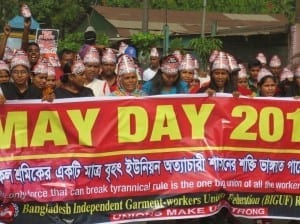
Members of Bangladesh Independent Garment Workers Federation marching today. Credit: Solidarity Center
More than 100 years ago, workers striking for an eight-hour day and living wages declared May 1 an annual date for international labor rights to honor workers and raise awareness of their struggles.
Around the world, many workers are still fighting for those basic rights. In Bangladesh, garment workers seeking to make their workplaces safe are forming unions, despite sometimes formidable odds, including violent attacks against workers and organizers.
Since last year, after the collapse of Rana Plaza and when garment workers began a serious push to organize and seek official recognition of their unions from the government, more than 100 unions have been registered. In the three years prior, only two unions were allowed to register.
“Now that we have a union, if (wage) payments are delayed, we can find out what the problem
is and work can go on,” said Rumi Akhter, a union leader. Rumi and her co- workers recently formed a union at a Weltex apparel factory in Dhaka, the capital (see video).
he Solidarity Center has been bolstering worker rights defense efforts in Bangladesh—including providing safety and health training, legal support and union building—for years. It recently established an emergency fund to help organizers and worker activists injured or otherwise harmed as they fight for better wages and working conditions. The country is one of dozens where the Solidarity Center assists local unions, worker centers and community groups to empower workers on the job and in civil society.
“In low-wage economies in general, companies find little reason to protect the rights and interests of workers—and corporate self-regulation has proven a faulty tool for ensuring healthy and dignified workplaces,” says Alonzo Suson, Solidarity Center Bangladesh country program director. “Without the relative strength of a union to represent them, vulnerable and impoverished workers cannot fight alone for their rights.”
May Day is a time to celebrate the historic achievements of trade unions. And as the International Trade Union Confederation (ITUC) points out, it is especially a time reaffirm our commitment to organize workers everywhere and support their fights for: freedom of association and collective bargaining; mnimum wages on which workers can live; universal social protection; and safe, healthy and sustainable jobs.

Apr 24, 2014
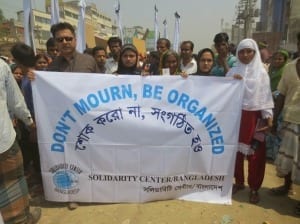
Garment workers are seeking to form unions to change unsafe working conditions like those at Rana Plaza. Credit: Solidarity Center
Thousands of Bangladeshis began gathering before dawn at the site of Rana Plaza, the multistory building that collapsed one year ago today, killing more than 1,110 garment workers and injuring at least 2,500.
Relatives of those killed, survivors of the tragedy and union activists made human chains and marched with banners and signs demanding worker rights, safe workplaces and justice for survivors and the families of those killed. Packing the plaza, marchers carried banners reading, “Pay up, long overdue for Rana Plaza Victims,” and “I don’t want to die for fashion.” Family members held photos of loved ones killed in the unnecessary disaster.
Dalia, a union leader from the Natural Apparels Workers Union (part of the Bangladesh Garment and Industrial Workers Federation, BGIWF) said that the compensation some of the survivors received was insufficient. She also said that families of missing workers should also receive compensation.
Garment workers and union leaders said that a year after the collapse of Rana Plaza, which housed five garment factories, promises made to the families of the victims remain unfulfilled. They called on the government to declare April 24 “labor safety day.”
Trade unions and other civil society organizations held daylong programs to mark the anniversary. Labor organizations placed wreaths at the monument erected in front of the collapsed factory site and the global union, IndustriALL, held a special program as part of its monthlong observance. The local government held a special prayer session as did the Bangladesh Garment Manufacturers and Exporters Association, at its building at Karwan Bazar in Dhaka, the capital.
Labor organizations taking part included the Bangladesh National Garment Workers Employees League (BNGWEL), BGIWF, the National Garments Workers Federation (NGWF) and Sommilito Garment Sramik Federation (SGSF).
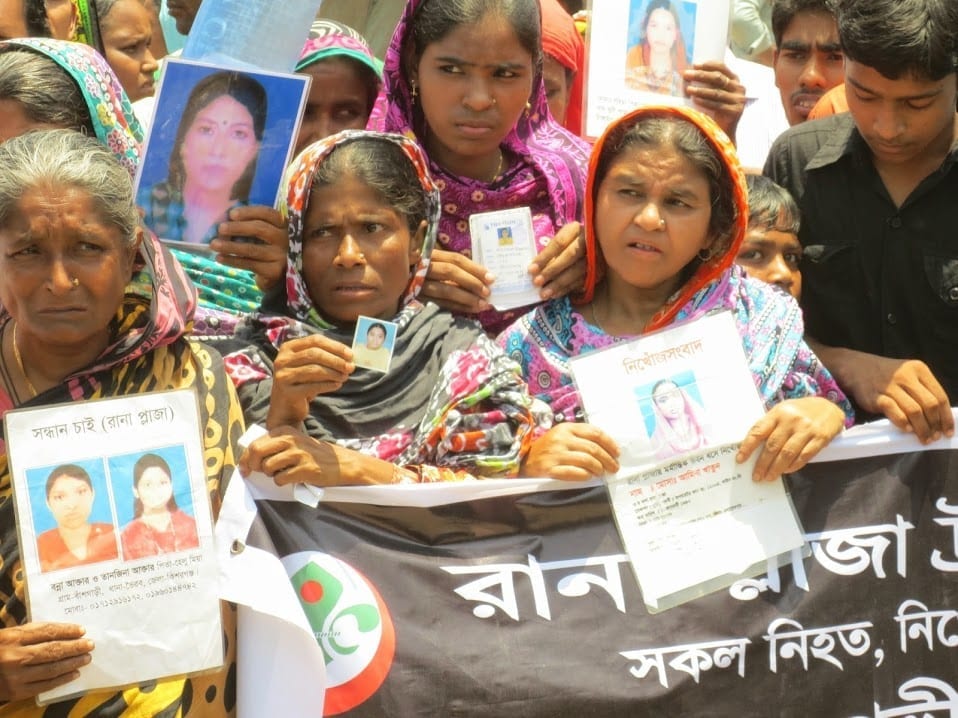
Apr 24, 2014
One year ago today, as the walls of the multistory Rana Plaza building collapsed around her, Moriom Begum was trapped, injured and unable to move in the dark, surrounded by the lifeless bodies of her co-workers.
A sewing operator at New Wave Style, one of five garment factories in Rana Plaza, Morium sat pinned beneath furniture for two days before she was rescued. More than 1,100 garment workers, mostly young women, were killed when the building pancaked around them. At least 2,500 garment workers were injured. Most, like Moriom, sustained such serious and life-altering injuries that they cannot work and may never again be able to do so, throwing their survival—and the survival of their families—into question.
Since the Rana Plaza disaster, 54 people have died or been injured at garment factories in Bangladesh, according to data compiled by Solidarity Center staff in Dhaka, the Bangladesh capital. The Rana Plaza tragedy closely followed the deadly Tazreen factory blaze, which killed 112 garment workers in November 2012. Survivors and the families of workers killed in both disasters have received little, if any, compensation, and many are struggling to survive.
Although labor organizations and prominent retailers created a $40 million compensation fund last December to aid the families of workers killed and injured at Rana Plaza, less than $20 million has been donated.
The government has taken several positive steps since the Rana Plaza tragedy, including accepting union registrations. To date, more than 100 have filed for official recognition. Yet when workers try to exercise their rights for safer workplaces, they are often harassed and threatened.
Garment workers seeking to form unions are intimidated by factory managers, who sometimes threaten to kill them, according to a recent Human Rights Watch report. Union organizers like Hasina, have been attacked, beaten, and in some cases, left for dead, when they spoke with garment workers about forming a union. If garment workers do succeed in registering their union, factory managers often prevent the workers from negotiating contracts for safer working conditions and living wages.
Garment workers and other workers in Bangladesh’s export-processing zones are subject to a different, much weaker set of labor laws than workers in the rest of the country, even though the $20 billion garment industry is Bangladesh’s biggest earner of foreign exchange.
The safety and lives of Bangladesh’s workers will not improve until they can exercise their rights, organize freely, be fairly compensated and ensure that their workplace is not a death trap. Reforming labor laws so they meet international standards for freedom of association and collective bargaining rights is part of the solution, says A. K. M. Nasim, senior legal counselor at the Solidarity Center’s office in Dhaka.
Employers and the government also must protect and respect the right of workers to form and join independent unions. Workers must not be intimidated, harassed, verbally or physically assaulted or fired from their jobs when seeking to form a union or represent their own interests, including the right to refuse to enter or remain in a dangerous workplace.
Moriom, who lost her right hand and suffers from constant pain, said the government and employers should understand the value of other people’s life.
If they value life, she said, they will ensure that no more garment workers are injured or killed.
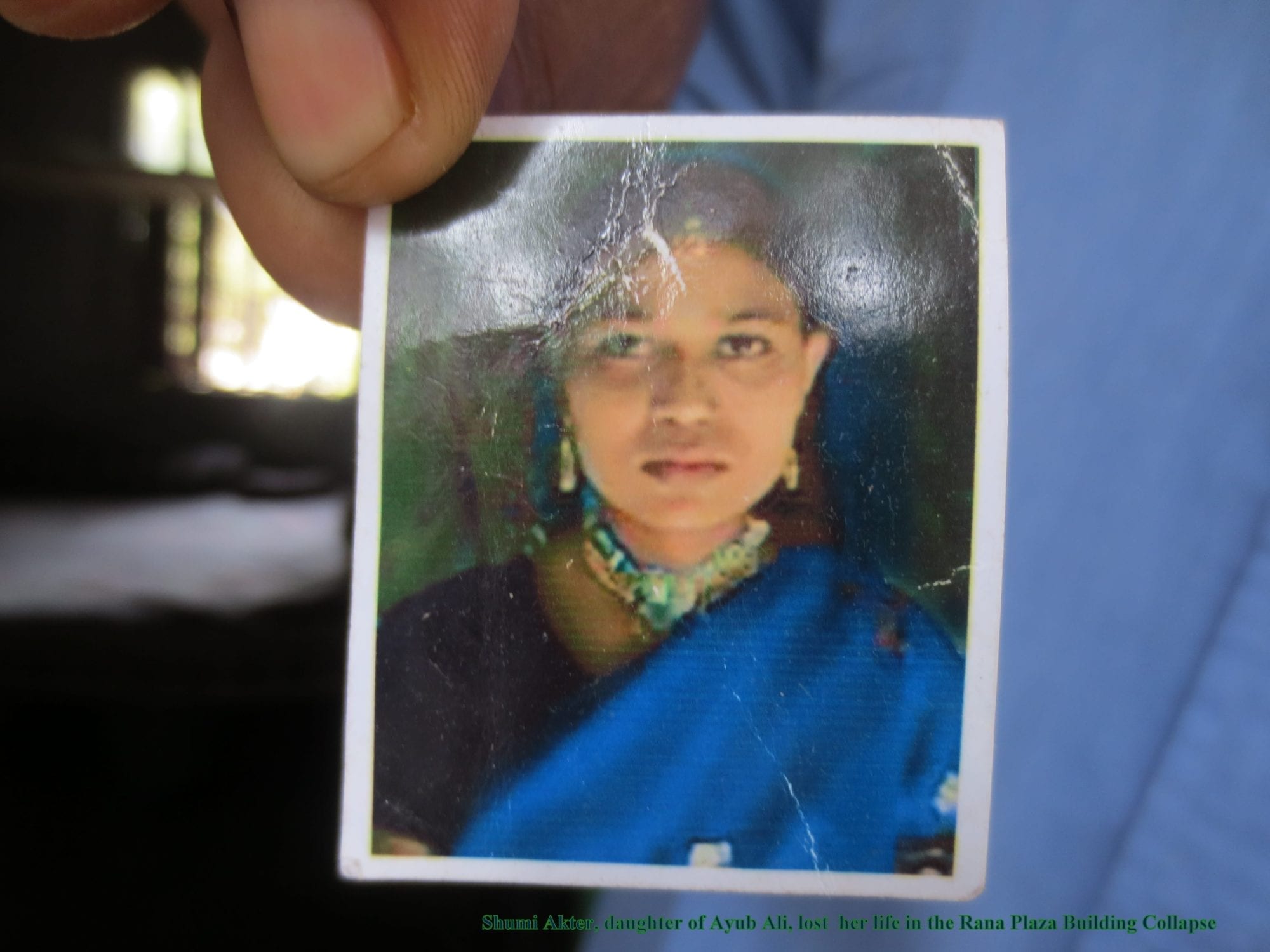
Apr 23, 2014
Shumi Akter was not quite 12 years old when she first started working at a garment factory in Bangladesh. By age 18, she had worked as a sewing machine operator at the New Bottom Style garment factory for more than two years, where the $75 a month she was paid helped support her husband and parents, with whom she lived.
On April 24, 2013, Shumi was among the more than 1,100 garment workers who perished in the collapse of the multistory Rana Plaza, which housed five garment factories, including New Bottom Style. Before leaving for work the morning she died, she gave her father more than half a month’s wages so he could pay a debt he owned.
“Now, I cannot find the happiness of life,” says Shumi’s father, Ayub Ali, a rickshaw driver who described his daughter as extremely affectionate.
Shumi’s mother, Amena Begum, still cries at night for her daughter and since the tragedy, has been unable to work at the garment factory where she was employed. Shumi’s body, found 11 days after the collapse, was recognizable only from her identification card and dress.
When Shumi’s parents went to collect their daughter’s body, government officials gave them $244 in compensation. Later, they also received $1,223 from the prime minister’s office and some $300 from private agencies.
Ayub Ali, who makes $3 a day, said “when one of the family member’s income discontinues, then the need is obvious.” Shumi had no children, but two younger siblings remain at home.
“I know very well that even lots of compensation can’t give my daughter back,” Ayub Ali said. “But the compensation can bring little bit of relief towards my family.”
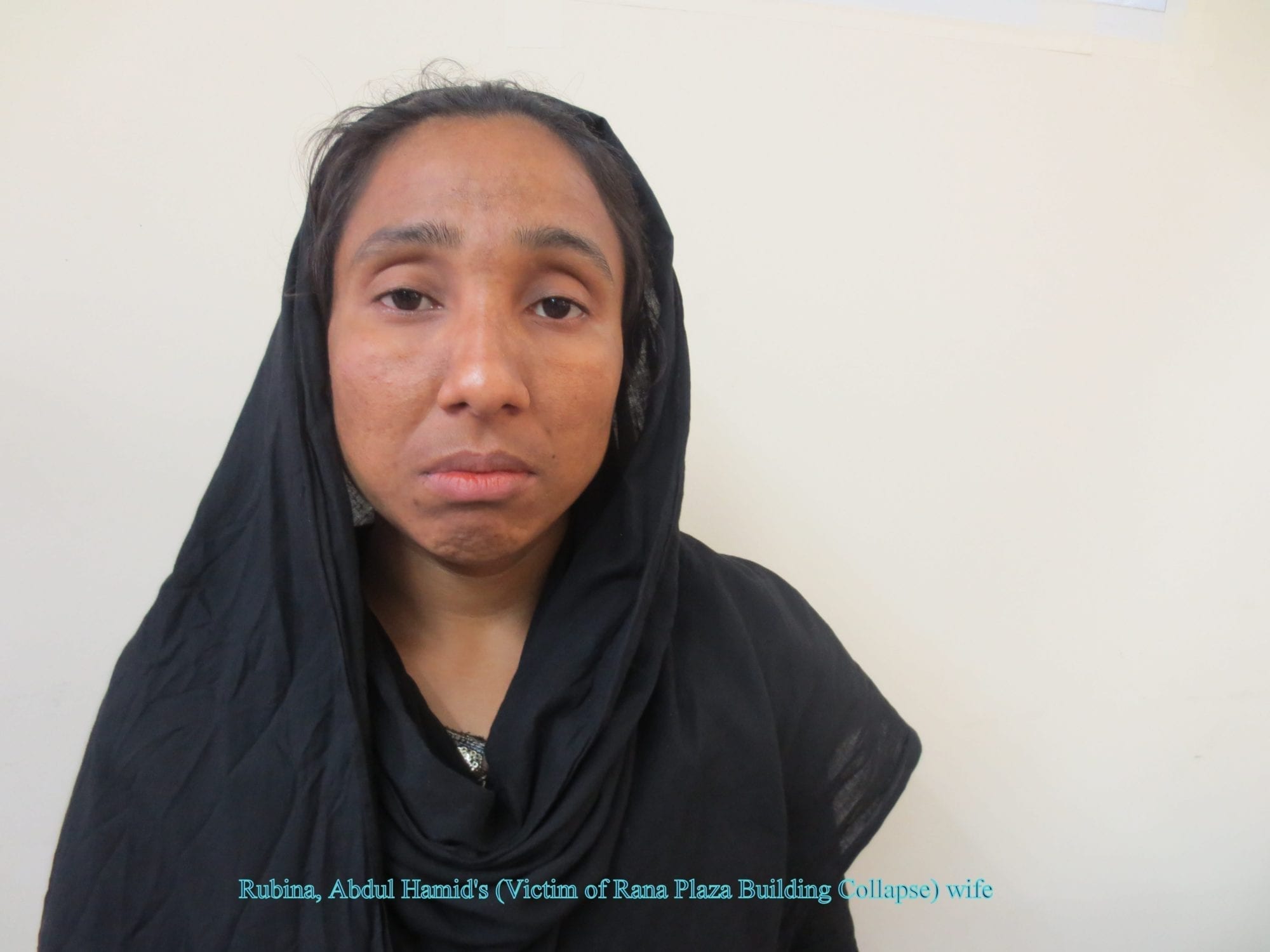
Apr 22, 2014
Rubina and her husband, Abdul Hamid, made enough to support themselves and their two children after they moved five years ago from a village to Dhaka, the Bangladesh capital. Both were employed as garment workers. But their efforts to ensure an even better future for their children ended April 24, 2013.
That day, the multistory Rana Plaza building collapsed, killing more than 1,100 workers, including Abdul Hamid. When Rubina left the factory where she worked to look for her husband in the hours after the disaster, her employer fired her.

Abdul Hamid was killed in the Rana Plaza building collapse. Photo Courtesy Rubina
“I want nobody to become helpless like me,” Rubina said, tears in her eyes. “Me and my husband thought if both of us work hard, we may bring a better future for our children.”
“We once had money. I could feed my children well. They didn’t have to face difficulties. But now I can’t feed them properly, can’t buy clothes for them.” Abdul Hamid, who worked as a cutting master at New Wave Style, one of five garment factories in Rana Plaza, was paid $110 to $122 per month with overtime.
Without a job in a garment factory, Rubina is making $24 a month by cleaning five houses. Her monthly rent, $18, takes up most of her earnings, and she is three months behind in payments. She also must pay for school admission and exam fees.
3, fear that if Rubina returns to work in a garment factory, she, too, will be killed. “They say, ‘Father died, if you go, you will die too. Please don’t go.’ ”
Rubina received $1,223 in compensation from the government—roughly 10 months of her husband’s salary—and another $183 from private organizations, but she will be forced to return to her village if she does not receive sufficient compensation so she can pay her rent and feed her daughters.
The day before Rana Plaza collapsed, engineers identified cracks so serious they said the building should be closed immediately. But many factory managers threatened workers they would be fired if they did not show up for work.
Rubina waited eleven days before some of her husband’s remains were found. She identified him by the pants he wore.
“Hundreds of people lost their lives,” she said. “They (the factory owners) shouldn’t take people’s lives.” She thinks management should get more safety training and the government should inspect the factories to ensure they are safe.
“If (the factory owners) don’t give me compensation, I can do nothing,” Rubina said. The owners, she said, have a responsibility. “My husband died. But his life was valuable.”







